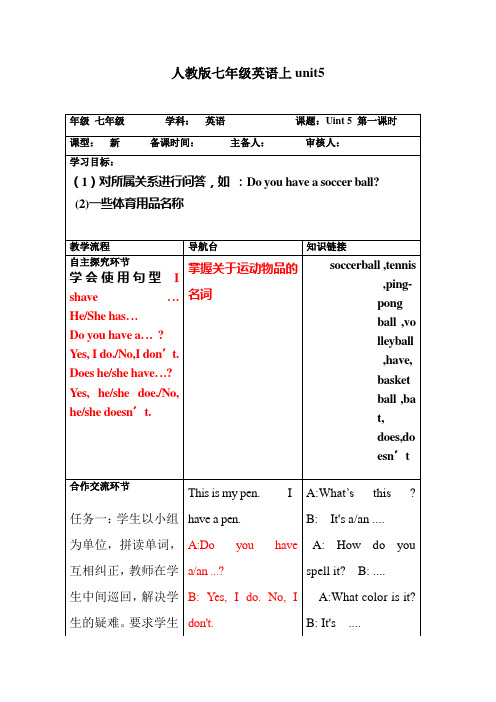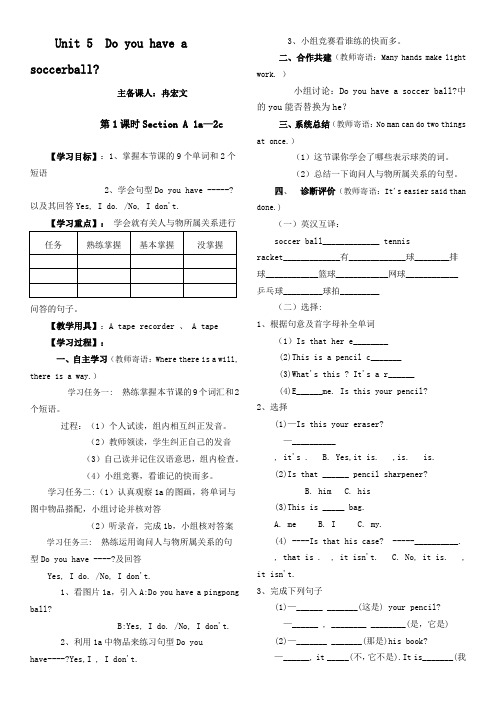人教版七年级上英语教案Unit5Period1
- 格式:doc
- 大小:59.55 KB
- 文档页数:3

人教版七年级英语上unit5年级七年级学科:英语课题:Uint 5 第一课时课型:新备课时间:主备人:审核人:学习目标:(1)对所属关系进行问答,如:Do you have a soccer ball? (2)一些体育用品名称教学流程导航台知识链接自主探究环节学会使用句型I shave …He/She has…Do you have a…?Y es, I do./No,I don’t. Does he/she have…? Y es, he/she doe./No, he/she doesn’t.掌握关于运动物品的名词soccerball ,tennis,ping-pongball ,volleyball,have,basketball ,bat,does,doesn’t合作交流环节任务一:学生以小组为单位,拼读单词,互相纠正,教师在学生中间巡回,解决学生的疑难。
要求学生This is my pen. Ihave a pen.A:Do you havea/an ...?B: Y es, I do. No, Idon't.A:What’s this ?B: It's a/an ....A: How do youspell it? B: ....A:What color is it?B: It's ....能准确的拼读单词,敢于领读单词。
放到早读任务二:要求学生能运用本节课所学的单词进行会话练习。
展示点拨环节完成听力练习1b,2a,2b,并根据听力对话进行自由交际要求学生会用第三人称he或she 造句,编对话。
并在此基础上,让小组进行竞争比赛He has a/an…Does he have a/an…?Yes, he does. No,he doesn’t.Sh e has a/an…Does she havea/an…?Yes, shedoes. No, shedoesn’t1.注意助动词do/does的使用。

Unit5 Doyouhaveasoccerball?1.单元话题以“介绍自己所拥有的体育用品”或“介绍自己或朋友、家人的运动喜好”展开,情境属于新课标“人与社会”主题范畴中的“文学、艺术与体育”这一主题群,涉及子主题“日常体育活动,重大体育赛事,体育精神”。
2.单元主题体现《中国学生发展核心素养》中的“自主发展”方面,提升学生的“健康生活”这一素养,立足于“自我管理”这一基本要点。
3.能读写本单元重点词汇。
4.掌握“play+球类名词”的用法,能运用正确的形容词描绘喜欢或者厌恶的体育运动。
5.通过听力训练,获取他人拥有某物的相关信息。
6.灵活运用do/does 引导的一般疑问句及含don't/doesn't 的否定句。
7.通过讨论球类用品的拥有情况,培养自己对体育项目的兴趣,热爱校园生活。
续表【课时建议】本单元建议5课时SectionA(1a-1c)(一课时)SectionA(2a-2d)(一课时)SectionA(GrammarFocus-3c)(一课时)SectionB(1a-1d)(一课时)SectionB(2a-SelfCheck)(一课时)词汇短语:主要采用图片及多媒体展示助记法。
基本句子:采用多媒体展示及交际法(利用多媒体展示两人进行交际时的情景)。
语法:就本单元话题“The sporting goods they own”运用一般疑问句谈论物品所属关系,采用freetalk加深印象。
第一课时SectionA (1a-1c)Step1 情景导入【参考案例】T:Lookatthesportsthings.Here,thepingpongballismine.Itbel ongstome.SoIhaveapingpongball.“Have”isan importantverbinthisunit.Nowlistencarefully:Doyouhaveapingpongball?I'maskingyouifyouhaveapingpongball.Ifyouhave,say“Yes,Ido.”;ifnot,say“No,Idon't.”设计意图:通过提问引出本课的语言目标,在师生问答中自然而然导入新课。


Unit 5Do you have a soccer ball?LanguageGoal【语言目标】Be able to talk about ownership.KnowledgeGoals 【知识目标】Key Wordsdo,have,tennis,ball,soccer,volleyball,basketball,let,us,go,we,late,has,get,great,play,sound,interesting,boring,fun,difficult,relaxing,watch,TV,same,love,with,sport,them,only,like,easy,after,class,classmateKey Phrases let’s=let us,watch TV,soccer ballKeySentencesDo you have a ping-pong bat?Yes,I do./No,I don’t。
Do they have a ping-pong ball?Yes,they do。
/No,they don’t.Does she/he have a tennis ball?Yes,she/he does./No,she/he doesn't。
Key Grammar The simple present tenseAbility Goals 【能力目标】Be able to talk about activities and express your own feelings about them。
Moral Goals【情感目标】Form a good habit of loving sports。
Teaching Time【课时】Four periodsPeriod 1Section A(1a-1c)Period 2Section A(2a -3c)Period 3Section B(1a-1d)Period 4Section B (2a-Shelf Check)Period 1 Section A (1a-1c)Teaching important points【教学重点】1.Key words &phrases:do,have,tennis,ball,ping-pong,bat,soccer,soccer ball,volleyball,basketball 2.Key sentences:Do you have a ping-pong bat?Yes,I do.Do you have a ping-pong ball?No,I don't。

Unit 5Do you have a soccer ball?Period 1 Section A (1a~1c)教学准备:1.教师:准备多媒体课件,搜集一些球类及球拍的图片,收集课文中所涉及的或学生常见的球类运动器材或有关的教学幻灯片或图片;制作1a 部分的插图和人物对话的课件,将听力部分的内容插入,通过询间对方的所属以及回答来引入新课,以及与球类有关的故事。
2.学生:搜集自己所了解的或曾经见过的球类运动器材的名称,并通过询问老师、同学或上网查询的方式了解有关球类的历史故事。
教材分析:通过uint4 单元询问物品在哪的学习,过渡到本单元谈论物品的所属关系,而本单元的核心语言项目是talk about ownership,展开学习;以及围绕make suggestions 展开能力训练。
主要话题是spending time with friends,培养同学间团结、友爱的精神。
学会使用have 对物品的所属进行提问及回答,以掌握行为动词在一般现在时中的构成和使用;同时引导学生使用所学的句型谈论自己在球类运动中的喜好,以及谈论自己对某项运动的感受等。
本部分1a1c通过图文及听力练习导入整个单元的话题,是整个Section A 的基础。
学情分析:本单元的主题是使用have对物品的所属进行提问及回答,以掌握行为动词在一般现在时中的构成和使用:同时引导学生使用所学的句型谈论自己在球类运动中的喜好。
行为动词在一般现在时的肯定句、否定句和一般疑问句中的构成和使用是初中英语教学中非常重要的内容,七年级的学生经过小学的学习后。
已经具备了一定的英语语言功底,在思雄能力方面有较强的记忆力和模仿力,但知识的扩展和运用能力有待于进一步提高,在认知心理方面,学生有较强的求知欲和表现欲。
并初步具备了合作探究能力。
核心素养:1.语言能力:Control key vocabularies such as tennis, soccer, ball, volleyball, basketball, pingpong and key sentences: Do you have...?Yes. I do. /No. I don't.2.学习能力:Ask and answer questions about the ownership.Train the students' municative petence and listening skill.3.思维品质:After learning these sport words, students can use them in real life and love doing sports.4.文化意识:Do sports every day and keep healthy.Teaching important points1.Key words & phrases:do,have,tennis,ball,ping-pong,bat,soccer,soccer ball,volleyball,basketball2.Key sentences:Do you have a ping-pong bat?Yes,I do.Do you have a ping-pong ball?No,I don't.Teaching difficult pointsBe able to use the word “have” properly.Teaching aidsPPT,pictures,a tape player,objectsTeaching procedures and ways★Step Ⅰ Lead-inLet’s enjoy a videosports song.Ask a question: How many kinds of sports are there in the video?T:Today,let's study Unit 5.★Step Ⅱ Presentation1.Show students a soccer ball and ask:T:What's this?Ss:It is a soccer ball.T:Yes,listen,soccer ball(read the word three times).I have a soccer ball.Do you have a soccer ball?S1:Yes…S2:No…S3:No…(Write down the title on the blackboard.)Then learn and read other new words and phrases(Write down these words and phrases on the blackboard.)2.Game: quick eyes and have a challenge of matching these words and pictures.After that work on 1a.★Step Ⅲ Cooperative inquiry1.Listening (1b)Listen and circle the words in the box.2.Listen again and repeat.3.PracticePractice the conversation in 1c with your partner and then make up your own conversations with picture.4 Ask and answer5 .Pair work★Step Ⅳ SummaryReview the words and sentences and tell the students : Sports make us healthy. Let’s do sports together.★StepⅤ Homework1.Write some sports things you have.2. Interview your friends and parents with the following sentence patterns:Do you have .......?Yes, I do. I have a...No, I don't . I don't have a...Blackboard writingTeaching reflection本单元的教学重点是学会动词have的一般现在时的肯定陈述句、否定句和一般疑问句。

Unit 5 Do you have a soccerball?主备课人:冉宏文第1课时Section A 1a—2c【学习目标】:1、掌握本节课的9个单词和2个短语2、学会句型Do you have -----?以及其回答Yes, I do. /No, I don't.【学习重点】:学会就有关人与物所属关系进行问答的句子。
【教学用具】:A tape recorder 、 A tape【学习过程】:一、自主学习(教师寄语:Where there is a will, there is a way.)学习任务一: 熟练掌握本节课的9个词汇和2个短语。
过程:(1)个人试读,组内相互纠正发音。
(2)教师领读,学生纠正自己的发音(3)自己读并记住汉语意思,组内检查。
(4)小组竞赛,看谁记的快而多。
学习任务二:(1)认真观察1a的图画,将单词与图中物品搭配,小组讨论并核对答(2)听录音,完成1b,小组核对答案学习任务三: 熟练运用询问人与物所属关系的句型Do you have ----?及回答Yes, I do. /No, I don't.1、看图片1a,引入A:Do you have a pingpong ball?B:Yes, I do. /No, I don't.2、利用1a中物品来练习句型Do youhave----?Yes,I , I don't.3、小组竞赛看谁练的快而多。
二、合作共建(教师寄语:Many hands make light work. )小组讨论:Do you have a soccer ball?中的you能否替换为he?三、系统总结(教师寄语:No man can do two things at once.)(1)这节课你学会了哪些表示球类的词。
(2)总结一下询问人与物所属关系的句型。
四、诊断评价(教师寄语:It's easier said than done.)(一)英汉互译:soccer ball_____________ tennisracket_____________有_____________球________排球____________篮球____________网球____________乒乓球_________球拍_________(二)选择:1、根据句意及首字母补全单词(1)Is that her e________(2)This is a pencil c_______(3)What's this ? It's a r______(4)E______me. Is this your pencil?2、选择(1)—Is this your eraser?—__________, it's . B. Yes,it is. ,is. is.(2)Is that ______ pencil sharpener?B. himC. his(3)This is _____ bag.A. meB. IC. my.(4) ----Is that his case? -----__________., that is . , it isn't. C. No, it is. , it isn't.3、完成下列句子(1)—______ _______(这是) your pencil?—______ , ________ ________(是,它是)(2)—_______ _______(那是)his book?—______, it _____(不,它不是).It is_______(我的)book.4、翻译下列句子(1)这是你的字典吗?不,它不是。
Starter Unit 3 Welcome! (Period 1)Section A教材分析本单元主题是“人与自然→自然生态→种植与养殖”。
本节课是本单元的第一节课,是一节听说课,主要包括图文匹配、听力练习、对话练习等一系列活动,并需要学生在听说的过程中掌握询问及回答“这/那/这些/那些是什么”、询问及回答数量的日常表达。
教学目标学完这一课,学生能够掌握:1.语音:元音字母a、e、i、o、u在闭音节单词中的发音;2.词汇:fun、yard、carrot、goose;3.能力:听懂并会写数字1—20的英文表达;在听力中抓住关键词;4.交际功能:(1)熟练使用句型“—What’s this / that? —It’s …”、“—What are these / those? —They’re …”询问及回答“这/那是什么”、“这些/那些是什么”;(2)熟练使用句型“How many …?”询问数量。
教学重点1.语音:元音字母a、e、i、o、u在闭音节中的发音;2.词汇:fun、yard、carrot、goose;3.重点句型:询问及回答“这/那/这些/那些是什么”的句式;询问数量的句式。
教学难点1.在听力中抓住关键词,分辨并写下数字1—20的英文表达;2.熟练运用询问及回答“这/那/这些/那些是什么”的句式和询问数量的句式。
教学过程新课导入首先,教师给学生展示一张园圃的图片,并就图片中的动物、植物和物品等询问学生“What’s this?”“What’s that in the picture?”“What are those?”“What are these?”,激活学生对于以前学过的关于动、植物名称的单词的记忆,并让学生对本节课将要学习的询问“是什么”的句型产生初步印象,并引导学生用适当的句型进行回答。
利用师生对话的形式,导入新课的内容,并起到课前热身的作用。
新知探究Step 1: New words and expressions新词要求学生在课前预习,教师可抽出适当时间进行检测,确保学生掌握本节生词,为新课学习做准备。
新人教版七年级上册英语教案Unit5-图文Unit5Doyouhaveaoccerball授课班级授课类型教学目标巩固课授课日期学时数The3rdperiod(SectionB1a–2b)1.Teachthewordlet,u.Getthetudenttoknowthefullformoflet’.2.Ha vethetudentknowthemeaningofintereting,fun,rela某ing,boring,difficult.3.GetthetudenttolearntoayLet’playaoccerbal l.Newword:intereting,fun,rela某ing,boring,difficult--Let’playoccer.--Idon’thaveaoccer.---Well,let’playvolleyball.---Thatoundgood.--Let’playoccer.--Idon’thaveaoccer.---Well,let’playvolleyball.---Thatoundgood.教学内容重点难点学情分析教学方法学习方法任务型教学、分级评价法、直观教学法、模仿示范法、情景教学和合作学习法课前预习、课堂内外练习、听说读写结合教学过程设计I.Warming-upandreviion1.Takatudent:DoyouhaveanotebookS:Ye,Ido.Takthewholec la:DoehehaveanotebookC:Ye,hedoe.T:DoyouhaveoccerballS:No,Idon’t.T:DoehehaveaoccerballS:No,hedoen’t.2.Tranlation1.我有一个排球。
2.你有乒乓球吗?3.他有两个篮球。
4.―――埃得有网球吗?备注课题引入本课作业。
Unit 5 Do you have a soccer ball?Period 1 (Section A 1a–2d)【教学目标】●知识目标1. Master the new words and useful expressions.2. Master the target language.3. Master the use of “have/has”.●能力目标1. Be able to make conversations using the target language.2. Be able to talk about ownership using have.●情感目标Lead students to love and enjoy sports.【教学重难点】●重点1. Master the new words and useful expressions.Words: do, does, have, tennis, ball, ping-pong, bat, soccer, volleyball, basketball, let, us, let’s, go, we, late, has, getExpression: soccer ball2. Master the use of “have/has”.①—Do you/they have a TV? —Yes, I/they do. No, I/they don’t.②—Does he/she have a soccer ball? —Yes, he/she does. No, he/she doesn’t.3. Improve students’ listening and speaking skills.●难点Be able to talk about the ownership using have.【教学准备】A tape recorder, some pictures of balls and handouts.【教学方法】任务型教学法、情景交际法、自主学习与合作学习相结合【课时安排】One period【教学过程】Step 1: GreetingsGreeting the students.T: Good morning! /Hello!/ Hi! ...Ss: Good morning! /Hello!/ Hi! ...Step 2: Lead-inT: Last week, we finished Unit 4. Today we are going to study a new unit, Unit 5.Ask and answerT: Can you tell me what the title of Unit 5 is? Yes, it’s “Do you have a soccer ball?” What do you think the unit is about?Ss:...T: Great! In this unit, we are going to learn to talk about ownership and some sports words. “Ownership” means “物品的所有者”.Step 3: Presentation1. Teach activity 1aT: First, please open your books to page 25 and look at activity 1a.(1) Look and findT: Please look at the picture in activity 1a. There are some balls in it. Do you know what kind of balls they are?(2) Match and discussT: Would you please match the words with the things in the picture? How many words do you know? Can you share the words you know with your partners? Please discuss with your partners and check whether your answers are the same.(3) Check the answersT: Let’s check the answers together.Answers: 2.f 3.c 4.e 5.d 6.b(4) ReadFirst, ask the students to read the words after the teacher, then read the words one by one again together.2. Teach activity 1b(1) Listen and circleT: Listen to the recording for the first time. Circle the words when you listen to it for the second time.(2) Check the answersAnswers: circled items: ping-pong bat, ping-pong ball3. Teach activity 1c(1) Lead students to read the conversations in 1a. Ask them to pay attention to the pronunciation and intonation.(2) Explain the languages points in the conversations.(3) Ask students to read the sample conversation in 1c. Encourage them to make their own conversations using the given words in the box.(4) Leave them several minutes to do this task in pairs.(5) Invite some pairs to act out their conversations for the whole class.Step 4: Practice1. Teach activities 2a(1) Go through the instruction in 2a with the class.(2) Look at the pictures in 2a.(3) Play the recording for the first time. Students listen and number the pictures.(4) Play the recording for the second time. Let students check the questions they hear, then check the answers.Answers: 3, 1, 4, 22. Teach activities 2b(1) Go through the instruction in 2b with the class.(2) Look at the pictures in 2b carefully.(3) Play the recording for the first time and tell students to only listen to them carefully.(4) Play the recording for the second time. Ask students to find the things in 2a and match them in the picture.Ask them to do it individually.(5) Then check the answers.Answers: 3, 2, 1, 4(6) Play the recording for the third time. And let students listen and repeat.3. Teach activity 2c(1) Ask the students to read through the conversations in pairs.(2) Give them three minutes to practice reading it.As students work, walk around the room, offering help if necessary. Correct pronunciation mistakes if any.(3) Ask several pairs to act out their conversations.Step 5: ConsolidationTeach activity 2d1. Ask students to read the conversation by themselves to get the main idea.2. Lead students to read the conversation sentence by sentence, and explain some languagepoints at the same time.3. Play the recording, and ask students to listen and repeat. Then ask them to role-play theconversation in pairs. Move around the classroom to check the progress.4. Invite several pairs to role-play the conversation for the whole class.【课堂小结】In this period, we’ve learned the use of have. And we’ve also learned how to talk about the ownership of things.【课后作业】1. Review the new words and useful expressions in this period.2. Practice the conversation in 2d in pairs and recite it.3. Finish the exercises in the workbook.4. Preview the next period.。